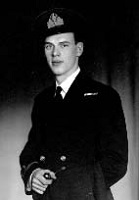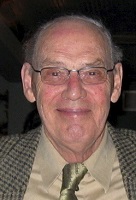|
A Royal Canadian Navy Historical Project
In memory of those who have Crossed the Bar
ROBSON, Thomas Beattie - Dr. Tom Robson, MD, FRCS, passed away on February 26, 2019, at the age of 97, at his retirement residence in London, Ontario. Predeceased by his wife of 64 years, Joyce, and their first-born son, Thomas (known in the family as "Rob"), and by his brother, Peter. He will be remembered with love by his daughter Gwyneth and husband Mike, his son Hugh, his son Ian and wife Diana, his son David and wife Julie, and his sister-in-law Marjorie Robson. Kind grandfather to Owen and Zoe Smith; Anne and Sophie Gwynne-Robson; Gail, Fiona, and Thomas Robson. Born in 1921 in Windsor, Ontario, to Dr. Russell and Gwendolyn Robson, Tom attended Walkerville Collegiate and the University of Toronto before serving with distinction as Lieutenant in the Royal Canadian Naval Volunteer Reserve (1941-45). Upon completing his medical degree and residency in obstetrics and gynecology, Tom returned to Windsor to practise medicine for over three decades, retiring as Chief of Staff of Metropolitan Hospital. As a father, Tom was quietly supportive of his five children, always giving them space to discover themselves and choose their own paths. His passions included reading, travel, the Art Gallery of Windsor, the Stratford Festival, gardening, and birdwatching. Tom Robson was a gentleman who loved his family and his community, art and nature, the earth and the sea. He was greatly loved; he will be greatly missed. Family will hold a private celebration of Tom's life in the spring, with interment at Victoria Memorial Gardens. (Windsor Star 09 Mar 2019)
M.I.D. Citation: ROBSON, Thomas Beattie, Lieutenant, Mention in Despatches, RCNVR, HMCS Cape Breton - Awarded as per Canada Gazette of 15 June 1945 and London Gazette of 14 June 1945. "For untiring zeal and a high sense of duty and loyalty. This Officer proved himself to be of valuable assistance as Watchkeeping Officer under the trying conditions of the North Atlantic, North Russia and Channel operations. Whilst performing the duties of Anti-Submarine Control Officer, he has shown cheerfulness and a willingness to be at work at all times."
Ships served in: HMCS KINGS - Appointed to Kings 25 Jun 1942 as a Prob. SLt, RCNVR (Navy List Sep 1942). Seniority dated 08 Jun 1942 (Navy List Mar 1943). HMCS QUESNEL - Served in Quesnel Sep 1942 - May 1943 (memoirs of Tom Robson) HMCS KINGS - Appointed to Kings 21 May 1943 as a SLt, RCNVR (Navy List Aug 1943) HMCS CAPE BRETON - Appointed to Cape Breton 19 Oct 1943 as a SLt, RCNVR (Navy List Oct 1943). Appointed Lt, RCNVR 19 Oct 1943 (Navy List Feb 1944) HMCS KINGS - Appointed to Kings 06 Nov 1944 as a Lt, RCNVR, for Short 'N' Course (Navy List Nov 1944) HMCS CAPE BRETON - Appointed to Cape Breton 23 Feb 1945 as a Lt (n), RCNVR (see note 1) (Navy List Mar 1945) HMCS HUNTER - Demobilized circa Aug/Sep 1945 (memoirs of Tom Robson) * (note 1: (n) - denotes an Officer who has qualified (in Canada) for Navigation Officer; in a ship, an Officer borne for Navigating Duties
Turning in My Tin Helmet
I grew up in Windsor and had completed one year of medical school at the University of Toronto when the war in Europe suddenly heated up. It was the summer of 1941. My dad had served in the First World War, which made me predisposed to think seriously about this war. In the army everyone starts out as a private. I chose to enlist in the Navy since they allowed qualified people to come in and be trained as officers. Also, the Navy seemed to offer more of a chance to travel and see the world. So, I went down to HMCS Hunter here in Windsor and enlisted. And travel I did.
In May of 1942, with my second year of medical school and a few months of training and drill at HMCS Hunter under my belt, I headed for Halifax as a probationary Sub Lieutenant. The Navy had taken over Kingís College University as the officerís training school. In September of 1942 I graduated and was appointed to a corvette, HMCS Quesnel, and we went to sea for the first time.
The Quesnel was part of a local escort force, and we shepherded and convoyed merchant ships on what they called the "triangle run." It was sort of a Halifax, Newfie-John, and New York routine. We dropped an awful lot of depth charges, but we never saw a submarine. The greatest enemy we faced was the North Atlantic weather. The officers had to live in bunks on the ship, while the crew lived in hammocks. When the ships were rocking the hammocks were remarkably steady; the bunks, on the other hand, were difficult to keep ourselves in.
In May of 1943, I was appointed back to training school as a training divisional officer. Four months later I was appointed to the frigate HMCS Cape Breton as both watchkeeping officer and anti-submarine officer. It was on a run back from Murmansk, in north Russia, that the Cape Breton ran into some German submarines. We were part of the advance screen of a convoy and ended up with two good explosions from the hedgehog (an apparatus that fired anti-sub bombs off the bow.) We aboard ship knew we had hit a German submarine. Our ship got credit for a possible sinking when the sonar records were submitted. The captain also put my name in the dispatches, which earned me a certificate of recognition "by order of the King."
While we were off the coast of Wales waiting for the word, our captain let each officer have an hour during the night to read the overall plan for D-Day. I donít think too many people as far down the ladder as I was in command got a chance to see this ahead if time. It detailed what the various units were going to do. It was outstanding.
A while later, after D-Day, I got word that I had been accepted for a navigation course back at Kingís College. But, my ship was not due to go back. So, I got dropped off on a jetty in the Faeroe Islands, off Iceland. Then a Royal Navy trawler took me to Scotland. The Canadian Navy had a depot just outside Glasgow, in a former insane asylum in Greenock. It was a standing joke in the Navy over there that the Canadians were in the insane asylum. Finally, I got passage on the Queen Mary back to New York.
After the four-month course at Kingís College, I was reappointed as navigating officer of the Cape Breton. I was serving aboard her when we got the word about V-E Day. Around the end of August 1945, I was on a six-week leave back here in Windsor (which my new bride and myself used as our belated honeymoon.) I decided to get out and go back to medical school. I sent a telegram to the rear admiral in charge and received word that I was to report to HMCS Hunter, right here in Windsor, for discharge.
After the medical exam and forms were completed, they said, "You have to turn in your tin helmet." Well, Iíd never been issued with a tin helmet; I never wore one; I had no idea what they were talking about. Still, they insisted they could not discharge me without the return of a tin helmet. So, I borrowed the $22 from my father-in-law who had driven me down there, bought a tin helmet from their supply and handed it back in. They signed my discharge papers and I was back in medical school for September classes in 1945
|
 For Posterity's Sake
For Posterity's Sake 

